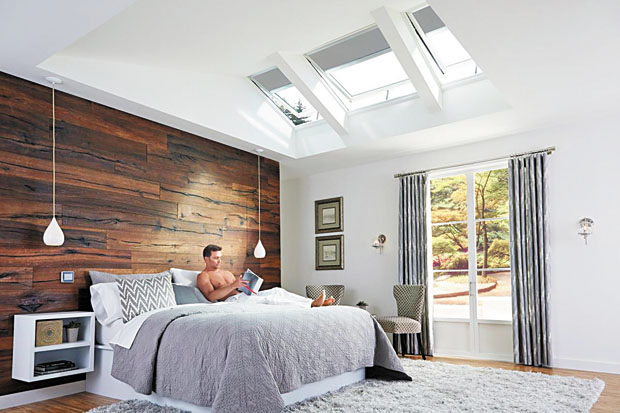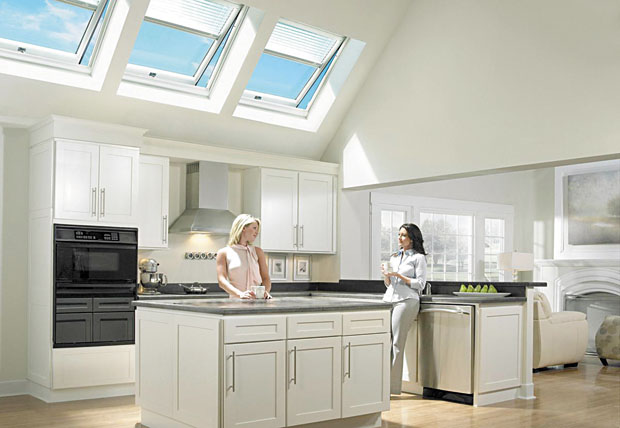Bring in fresh air, light with home upgrades
Most people probably think of windows and skylights only when they’re buying or selling a house, when they get dirty, when they leak or when the kid next door lobs a baseball through one. Yet the glass in your home arguably is among its most important features, directly impacting the structure’s overall energy efficiency and livability.
Well-maintained, operational windows and skylights provide abundant natural light and passive ventilation, and models are available that maximize insulation values as well. If you’ve been overlooking the glass in your home even while you’ve been looking through it, take a moment to reflect on its condition, and whether it’s helping you save energy or costing you money.

RProgrammable remote control units can operate your skylights and blinds 24 hours a day.
How windows work in your favor.
Over time, homes have become much more energy efficient — which is good for the environment and your wallet — and better windows and skylights have a lot to do with that improvement.
The National Fenestration Rating Council rates windows based on a number of basic criteria, including the U-factor, which measures heat loss through the glass, and solar heat gain, which indicates how much heat enters a room through the glass. Understanding how those two measures work and what they mean can help you choose the type of window that’s best for where you live. For example, if you live in a hot climate you may want to consider selecting windows that minimize solar heat gain.
Many new technologies in glass design have enhanced the efficiency of windows.
For example, the insulating effect of double-pane windows gets an added boost with the addition of blinds. Electrostatic film allows homeowners to make window glass clear or opaque with the touch of a button. Another type of window coating admits natural light, but blocks out most of the infrared energy and ultraviolet rays that, along with artificial lighting and other factors, create heat and cause fading of materials inside the home.
In addition to the energy efficiency of the glass itself, the quality and maintenance of the structure surrounding the glass — the framework that makes it a window instead of just a pane of glass — also affect its efficiency. Whatever type of window you choose — vinyl, wood, fiberglass or metal — or the age of existing windows, properly sealing them helps ensure they’ll do their job as efficiently as possible. You can learn more about energy performance ratings and energy-efficient windows at energy.gov.

With fresh air skylights you can still have natural light and passive ventilation, along with privacy and a view of the stars at bedtime. See details at whyskylights.com.
The advantages of skylights.
Skylights always have offered many functional and aesthetic advantages for homeowners. They emit natural light, which can help reduce dependence on artificial light sources. Fresh air skylights also can provide passive ventilation to remove humidity, fumes and excess heat from a home — all of which improve indoor air quality. Today, high-tech, energy-efficient glass in modern skylights also works hard to help your home function optimally.
Manufacturers like Velux America utilize glass in its no-leak, solar-powered fresh air skylights that stay cleaner and clearer, reduce outside noise and protect the contents of your home — such as carpet and furnishings — from the fading effects of the sun. Velux’s “Clean, Quiet & Safe Glass” is laminated with a super thin coating of titanium dioxide and silicone dioxide to help keep the glass cleaner, and reduce outside noise by up to 25 percent, compared to a standard double-pane glass, and 50 percent, compared to a plastic skylight. The glass sheds water more effectively and has a U-value and UV protection superior to regular tempered glass.
Remote-controlled, solar-powered blinds in decorator styles and colors further improve a skylight’s overall energy efficiency. You may be eligible for a 30 percent federal tax credit on solar skylights, blinds and installation cost. Visit veluxusa.com to learn more.
Humans have been making glass and using it in windows for thousands of years. Today’s windows and skylights draw on thousands of years of human innovation and some very recent modern technological advances to help keep homes comfortable, secure and efficient.
This article is courtesy of Brandpoint.